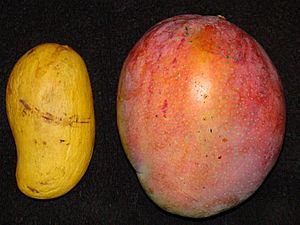Ataulfo (mango) facts for kids
Quick facts for kids Mangifera 'Ataúlfo' |
|
|---|---|

Ataúlfo mango (left), Tommy Atkins (right)
|
|
| Genus | Mangifera |
| Species | Mangifera indica |
| Cultivar | 'Ataúlfo' |
| Marketing names | Champagne |
| Origin | Soconusco, Chiapas, MX |
The Ataúlfo' mango is a special type of mango that comes from Mexico. You might also hear it called 'young', 'baby', 'yellow', 'honey', or 'Champagne' mango. These mangos are bright golden yellow. They usually weigh between 6 and 10 ounces (about 170 to 280 grams). They have a unique, slightly curved shape. Their skin is yellow with a golden blush.
What makes them so popular? Their inside flesh is super smooth and buttery. It doesn't have those stringy fibers you sometimes find in other mangos. The pit (seed) inside is also quite thin. The flesh is a deep yellow color and tastes very sweet. It has about 15 grams of sugar per 100 grams. This gives it a rich, sweet flavor. The mango was named after a grower named Ataúlfo Morales Gordillo. Since 2003, the Ataúlfo mango has been recognized as one of Mexico's special "Designations of Origin." This means it's officially linked to its home region.
Contents
Where Do Ataúlfo Mangos Come From?
The Mexican government officially recognized the Ataúlfo mango's special origin. This means it's protected as a unique product from the state of Chiapas. The Ataúlfo mango is related to the Philippine mango. This type of mango came to Mexico from the Philippines before 1779. It arrived through the Manila-Acapulco galleon trade.
Over time, the Philippine mango mixed with other mango types in Mexico. This led to the creation of the Ataúlfo mango. Even so, the Ataúlfo is still considered a Philippine-type mango. This means its seeds can produce more than one sprout (it's polyembryonic). Other mango types, like Indian ones, usually only produce one sprout from a seed (they are monoembryonic).
In 1958, a scientist named Hector Cano Flores found the Ataúlfo mango. He reportedly made a copy of it, which he called IMC-M2. In 2003, the Mexican government made an important announcement. They officially protected the name "Mango Ataúlfo del Soconusco Chiapas." This means only mangos grown in certain areas of Chiapas, Mexico, can use this name. These are the areas where Ataúlfo Morales Gordillo first grew them.
How Are Ataúlfo Mangos Grown?
Ataúlfo mangos grow best in warm, moist places. They need summer rains to thrive. The temperature should not drop below 5 degrees Celsius (41 degrees Fahrenheit). The perfect temperature for these mangos is around 28 degrees Celsius (82 degrees Fahrenheit). They also need a good amount of rain, between 1090 and 3000 millimeters (43 to 118 inches) each year. This rain usually falls from April to October.
Ataúlfo mangos are grown in several Mexican states. These include Michoacan, Sinaloa, Nayarit, Jalisco, Veracruz, and Chiapas. They are usually sold between March and September. In the state of Chiapas, growing mangos was a very important farming activity in 2008. It was the sixth most important crop. It came after corn, beans, coffee, sugar cane, and cocoa. Most of the Ataúlfo mangos in Chiapas are grown in the Soconusco coastal region. Farmers estimate that about 18,000 hectares (44,500 acres) of Ataúlfo mangos are grown in the state.
How Are Ataúlfo Mangos Used?
Ataúlfo mangos became very popular in the United States in the late 1990s. However, they had been a major crop in Mexico for many decades before that. By 2009, they were the second most popular type of mango sold in the U.S. The Tommy Atkins mango was the most popular. As of 2018, Ataúlfo mangos made up almost 20% of all mangos brought into the U.S.
Before 2014, not many Mexican Ataúlfo mangos were sold in Europe. This was because shipping them by air was too expensive. But in December 2014, a new way of shipping started. A company in the United Kingdom began shipping them by sea. They picked the mangos when they were almost ripe. Then, faster sea shipping allowed the mangos to ripen fully during the trip. European customers are willing to pay more for high-quality, ready-to-eat mangos.
See also
 In Spanish: Mango Ataúlfo para niños
In Spanish: Mango Ataúlfo para niños

